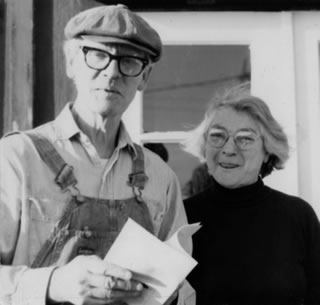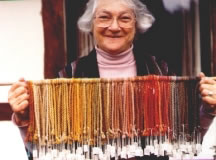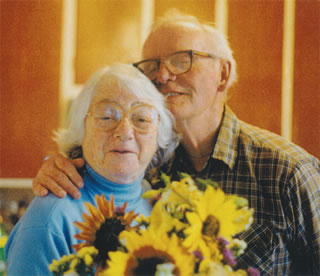Sacred Art - Page 8
 |
|
|
 |
|
|
 |
|
|
|
|
Miriam Rice Surged while Ray Turned Inward
When Ray Rice and Miriam Cohen met as students at Art Students League in New York, she was the better-known artist.
A prodigy, Miriam (1918-2010) had studied at Yaddo, an artists colony in upstate New York, and won early sculpture competitions.
But for much of her life with Ray, whom she married in 1940, he was the public figure. She came into her own in the early 1970s thanks to a field she virtually invented—mushroom dyes.
“Miriam Rice spent 35 years unlocking the full spectrum of color of natural dyes from mushrooms,” daughter Felicia Rice says. “She’s well known among mushroom people, weavers, natural dyers. She’s really big in India. This is an international movement she was at the heart of.”
“While he [Ray] was pulling out of the public limelight, she was moving into it.”
Throughout their lives together, both Ray and Miriam created art. But until the 1970s, she had to fit her art around other duties. It was Miriam who raised the couple’s three children, cooked, and kept house.
Miriam was far more outgoing than Ray, much more the talker, and could do many things at once—including making art. “She would never do something that couldn’t be interrupted,” Felicia recalls.
“I didn’t feel I was any lesser of an artist because I wasn’t working all the time at it,” Miriam said during the same interview.
Ray wanted her to spend more time doing art. She’d be making jelly from berries, and he would say, “What are you doing that for? You should be doing sculpture.”
“I think living is significant,” Miriam continued. “What gives you pleasure or satisfaction is what you should do.”
Ray and Miriam, while supporting each other as artists, never collaborated—though Ray once suggested it. “I didn’t think it would work,” Miriam told interviewer Yvonne Mary Peppin in 1978, “because we had a close relationship with living together.”
In Mendocino, Miriam taught children’s classes at the Mendocino Art Center for decades. She also discovered batik and investigated alternative dyes. In her classes, she’d long made dyes from carrot tops, onions, and other food scraps.
“Throughout my high school years, our family room was draped with fabric in various stages of being waxed and dyed,” daughter Mira wrote. Once Miriam began cooking up mushroom dyes, the kitchen became a quasi-industrial site. “There was always something bubbling on the back of the stove,” Felicia says.
“She was always looking around in her environment for what could be used to make art,” Felicia says, “Used milk cartons to make prints. Scraps of newspaper could be used. Recycle, reuse, and repurpose.”
Miriam turned the Rice’s compact cottage into an international center for mushroom research, with artists and researchers knocking on the door. She wrote books on the subject, and helped found the International Mushroom Dye Institute and a series of international seminars. The 13th annual International Fungi & Fibre Symposium, in Mendocino, celebrated her 90th birthday.
“She used to drive along the back roads in Mendocino,” her friend and illustrator Dorothy Beebe wrote, “with her eyes searching the side of the road for mushrooms, able to spot a Dermocybe phoenicea at 20 yards—and be out of the car and have it picked while barely slowing down, I swear, or at least so it seemed to me at the time!”
• Miriam Rice’s book Mushrooms for Dyes, Paper, Pigments & Myco-Stix remains in print.




